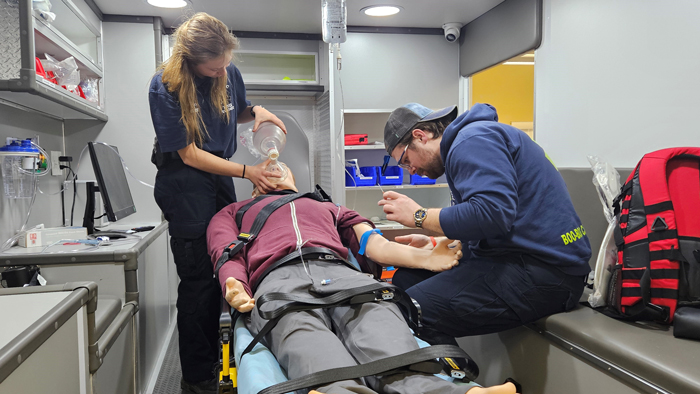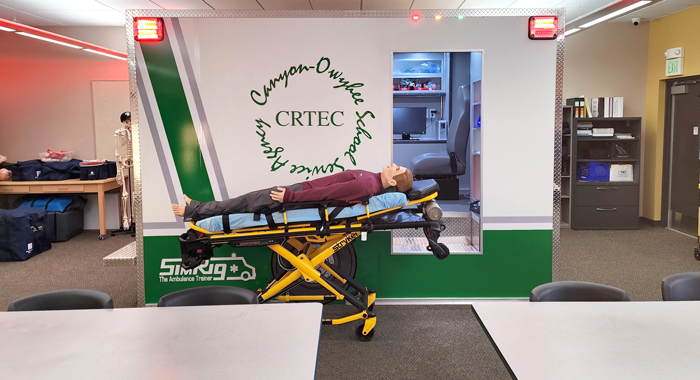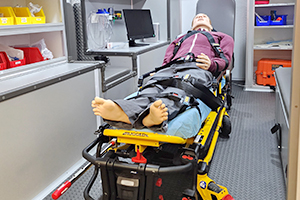COSSA Advanced EMT Class
- Need: To increase the number of Advanced Emergency Medical Technicians (Advanced EMTs) in rural Idaho and neighboring states.
- Intervention: An Advanced EMT class offered to students at five rural high schools, the first of its kind in the country.
- Results: Two students graduated from the class in its first year, with at least two more expected to enroll in the 2024-25 school year.
Description
Idaho, where many rural communities are experiencing an ongoing shortage of EMS workers, is one of six states that allow people younger than 18 to enroll in Emergency Medical Technician (EMT) training with parental consent. In Idaho, you can earn your EMT or Emergency Medical Responder (EMR) license at age 16 and your Advanced Emergency Medical Technician (Advanced EMT) or Paramedic license at 18.
The Canyon Owyhee School Service Agency (COSSA) Regional Technical and Education Center, which offers career technical education programs to students at five rural high schools in western Idaho (Notus Senior High School, Parma High School, Wilder High School, Homedale High School, and Marsing High School), had previously offered a one-year EMT training course to high school seniors. In the 2023-24 school year, COSSA opened the EMT class to juniors and established an Advanced EMT course for seniors who had already earned their regular EMT certification.

The COSSA course was the first Advanced EMT class for high school students in the country. Program leaders hope the training will produce more EMTs starting in the field at an advanced level, and will serve as a foundation and future part-time work opportunity for students who go on to other careers.
The class, including nearly $200,000 worth of new supplies and equipment, has been funded primarily through the Idaho Division of Career Technical Education's Leading Idaho Grant program.
Services offered
Students in the Advanced EMT course attend classes at the home high school in either the morning or afternoon, and come to COSSA for the rest of the day. The class runs three hours a day, four days a week, for the duration of the school year. Students participate in hands-on training using an in-classroom ambulance simulator, mannequin, and other equipment.

In the 2024-25 school year, Advanced EMT students will also receive training in wildland firefighting from the Parma Fire Department and will have the chance to earn a wildland firefighting certificate along with their Advanced EMT license.
Results

Two students graduated from the class in 2024 and passed their Advanced EMT exams. One student, who worked weekends during the school year at an ambulance service over the border in rural Oregon, continued to work for the same agency after graduation as an Advanced EMT.
Between two and five students are expected to enroll in the class in the 2024-25 school year.
Challenges
Finding funding for supplies and filling out all of the necessary paperwork to start the program was initially a challenge, but was made easier with the support of school administration, the Idaho Division of Career Technical Education, and the Idaho EMS Physician Commission.
Replication
Schools that want to offer an Advanced EMT Class must get the approval of both their board of education and their state EMS commission, as well as any other required local or regional entities.
Contact Information
Scott Webb, Emergency Medical Services InstructorCOSSA Regional Technical Education Center
webbs@cossaschools.org
Topics
Emergency medical services
· Emergency medical technicians and paramedics
· Health workforce education and training
· Health workforce pipeline
· Licensure and certification of health professionals
States served
Idaho
Date added
July 17, 2024
Suggested citation: Rural Health Information Hub, 2024 . COSSA Advanced EMT Class [online]. Rural Health Information Hub. Available at: https://www.ruralhealthinfo.org/project-examples/1141 [Accessed 19 December 2025]
Please contact the models and innovations contact directly for the most complete and current information about this program. Summaries of models and innovations are provided by RHIhub for your convenience. The programs described are not endorsed by RHIhub or by the Federal Office of Rural Health Policy. Each rural community should consider whether a particular project or approach is a good match for their community’s needs and capacity. While it is sometimes possible to adapt program components to match your resources, keep in mind that changes to the program design may impact results.
